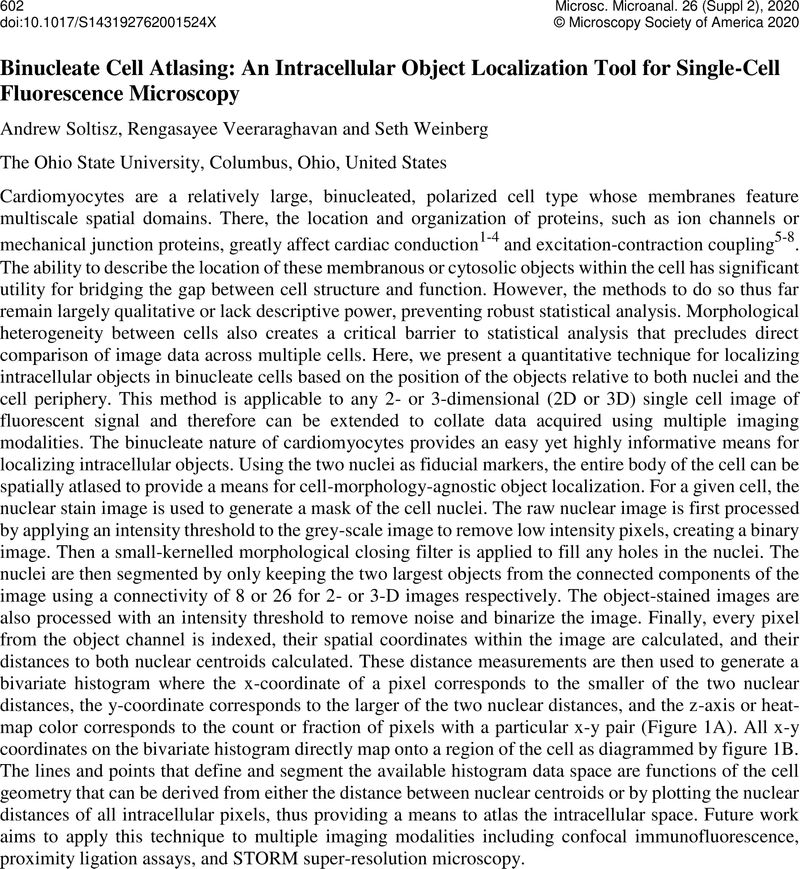No CrossRef data available.
Article contents
Binucleate Cell Atlasing: An Intracellular Object Localization Tool for Single-Cell Fluorescence Microscopy
Published online by Cambridge University Press: 30 July 2020
Abstract
An abstract is not available for this content so a preview has been provided. As you have access to this content, a full PDF is available via the ‘Save PDF’ action button.

- Type
- Illuminating Health and Disease at New Frontiers of Spatiotemporal Resolution and Adaptive Microscopy
- Information
- Copyright
- Copyright © Microscopy Society of America 2020
References
Veeraraghavan, R and Gourdie, R. Stochastic Optical Reconstruction Microscopy-based Relative Localization Analysis (STORM-RLA) for Quantitative Nanoscale Assessment of Spatial Protein Organization. Molecular biology of the cell. 2016;27:3583-3590.10.1091/mbc.e16-02-0125CrossRefGoogle ScholarPubMed
Veeraraghavan, R, Hoeker, GS, et al. The adhesion function of the sodium channel beta subunit (beta1) contributes to cardiac action potential propagation. Elife. 2018;7.10.7554/eLife.37610CrossRefGoogle ScholarPubMed
Veeraraghavan, R, Lin, J, et al. Sodium channels in the Cx43 gap junction perinexus may constitute a cardiac ephapse: an experimental and modeling study. Pflugers Arch. 2015;467:2093-2105.10.1007/s00424-014-1675-zCrossRefGoogle ScholarPubMed
Veeraraghavan, R, Lin, J, et al. Potassium channels in the Cx43 gap junction perinexus modulate ephaptic coupling: an experimental and modeling study. Pflugers Arch. 2016;468:1651-61.10.1007/s00424-016-1861-2CrossRefGoogle ScholarPubMed
Radwanski, PB, Brunello, L, et al. Neuronal Na+ channel blockade suppresses arrhythmogenic diastolic Ca2+ release. Cardiovascular research. 2015;106:143-52.10.1093/cvr/cvu262CrossRefGoogle ScholarPubMed
Radwański, PB, Ho, H-T, et al. Neuronal Na+ Channels Are Integral Components of Pro-Arrhythmic Na+/Ca2+ Signaling Nanodomain That Promotes Cardiac Arrhythmias During β-Adrenergic Stimulation. JACC: Basic to Translational Science. 2016;1:251-266.Google ScholarPubMed
Struckman, HL, Baine, S, et al. Super-Resolution Imaging Using a Novel High-Fidelity Antibody Reveals Close Association of the Neuronal Sodium Channel NaV1.6 with Ryanodine Receptors in Cardiac Muscle. Microsc Microanal. 2020:1-9.Google Scholar
Koleske, M, Bonilla, I, et al. Tetrodotoxin-sensitive Navs contribute to early and delayed afterdepolarizations in long QT arrhythmia models. The Journal of general physiology. 2018.10.1085/jgp.201711909CrossRefGoogle ScholarPubMed



